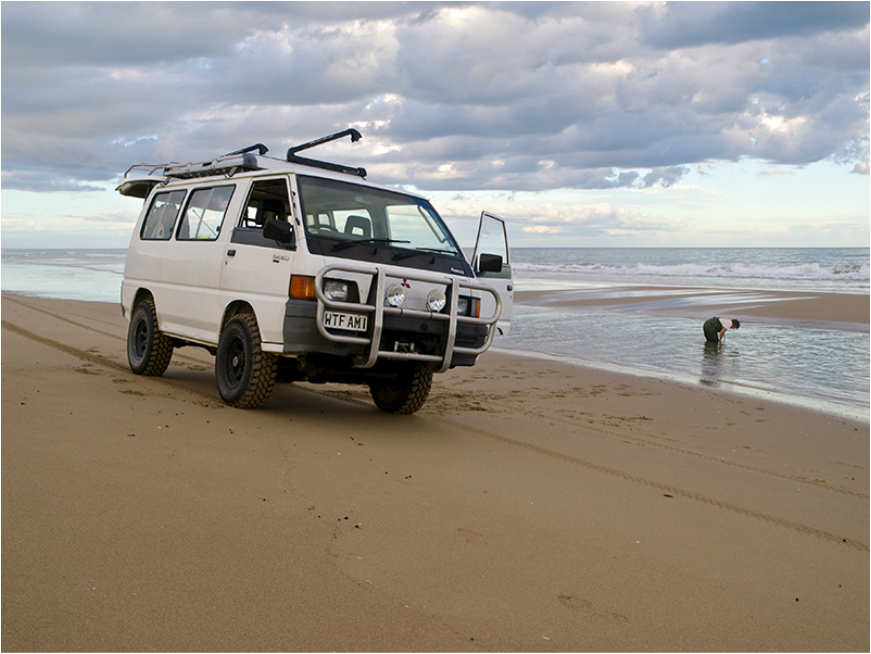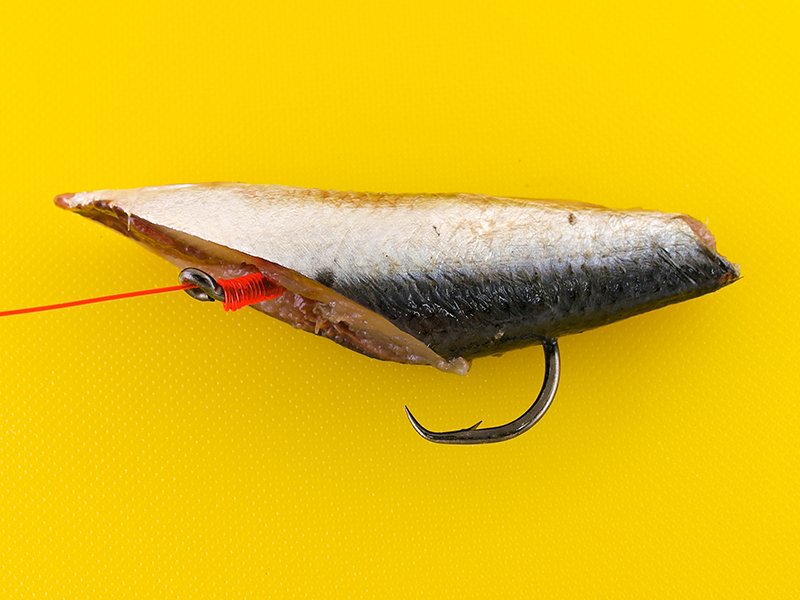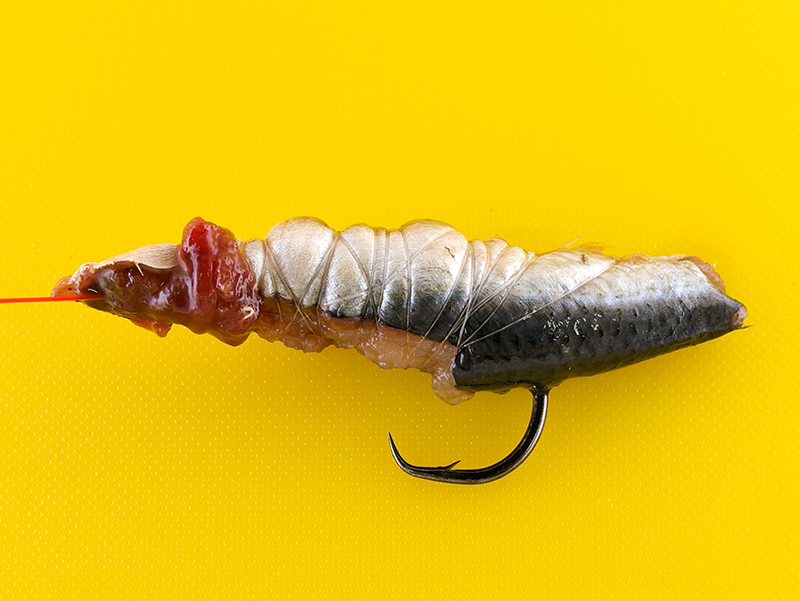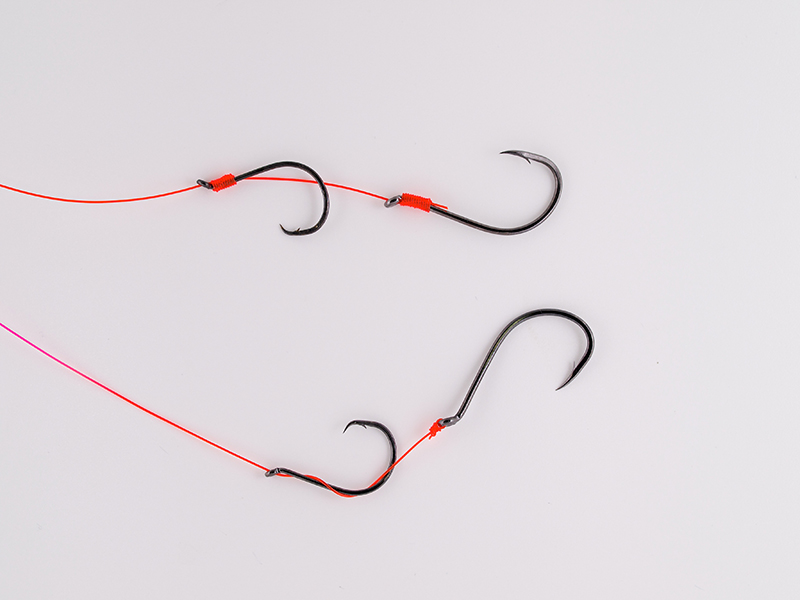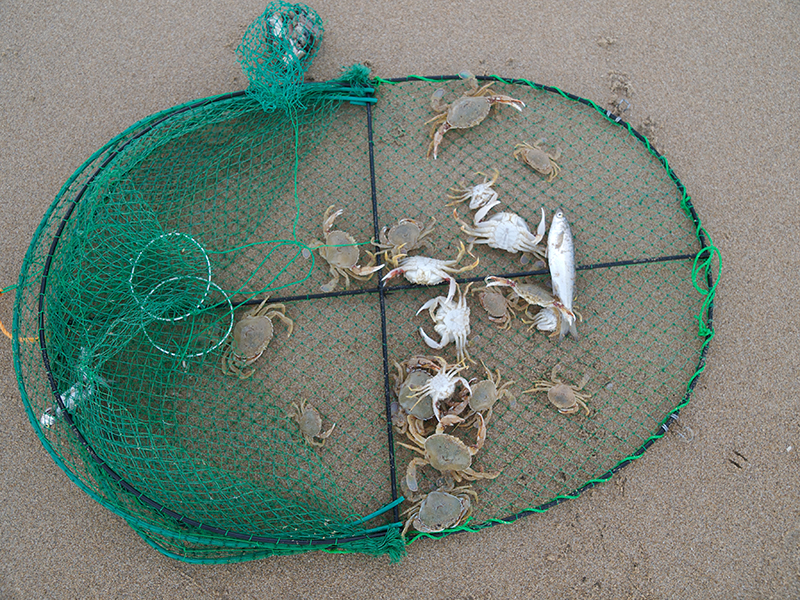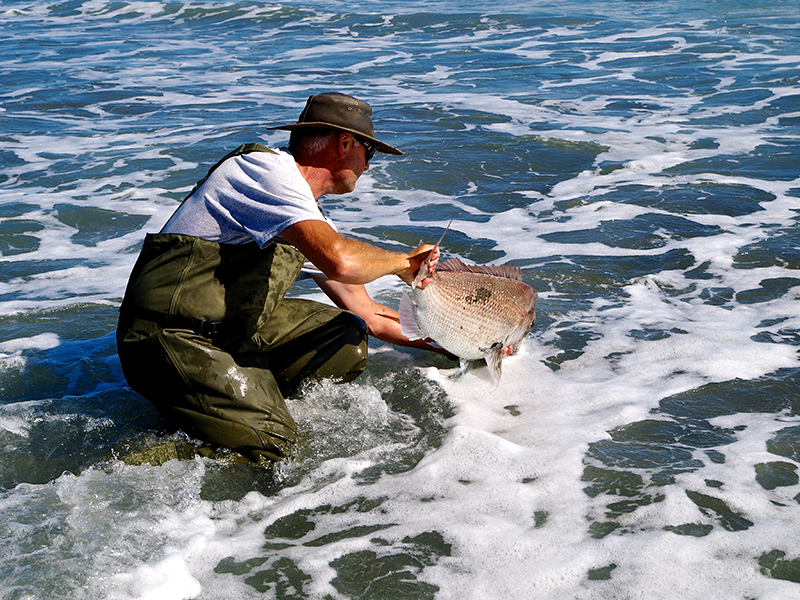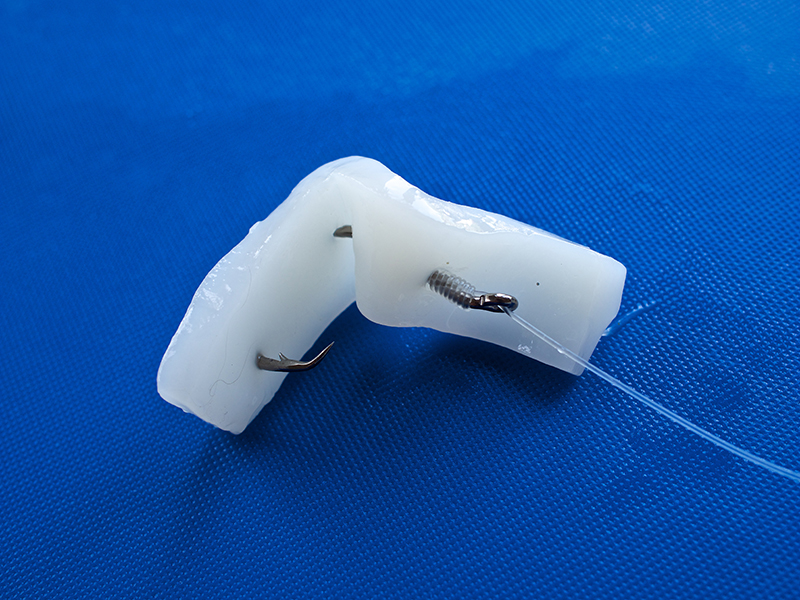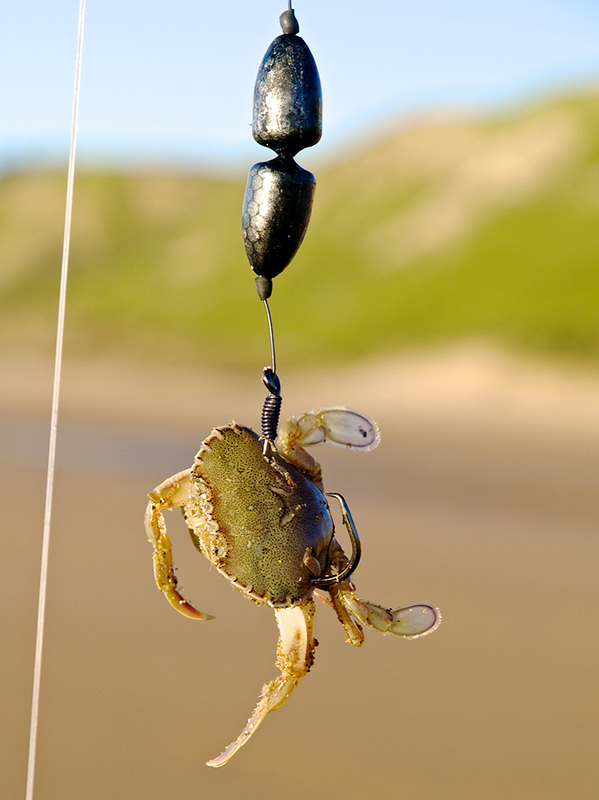tackle talk
Surfcasting Baits 101
Words and photos by Mark Roberts
Words and photos by Mark Roberts
The advice in this article is aimed primarily at the beginner surfcaster. It covers the use of pilchards and squid - the most readily-available baits in tackle shops - and paddle crabs, a bait that, with a little effort, is readily obtainable along the coastline of New Zealand.
|
Half the body of a pilchard cut on an angle to create a good shape. Note that you can bind bait elastic into the snell knot coils. The hook shown is a 6/0 circle.
|
The section of pilchard body is now bound to the hook with bait elastic, and the point of the circle hook is adequately exposed. That’s not so easy to achieve if a pilchard is cut into square cubes. Pilchards that are still slightly frozen are easier to work with, so don’t be too keen to thaw your entire supply on arrival at the beach. Keep some in ice in a chillybin.
|
The top rig is the one I prefer when baiting a whole pilchard, although a ‘whole’ pilchard is often minus its head and tail, depending on its original size. The bottom rig is one most surfcasters use for a whole pilchard. It’s easier to tie and the sliding hook can be moved around—but the hook-up rate may be inferior. It’s virtually impossible to prove this one way or the other though — so go with your instincts.
|
|
A collapsible Opera House Bait and Crab Catcher with a catch of baby paddle crabs. Chris has since added lead weights to this inexpensive net to hold it steady in water. These crabs are a good size for bait - they’ll also keep well for about two months in a freezer if you happen to catch more than you need for one fishing session. You’re allowed to take 50 paddle crabs per day, which I consider ridiculous. There should be no limit. Their numbers have increased significantly with the reduction in the populations of their main predators: spotted smoothhounds, snapper, gurnard.
|
Brent Rolston of the Feilding Surfcasting Club releases a snapper of approximately seven kilograms at Waverley. This fish took a chunk of pilchard on a single hook. Between us, we landed another sixteen snapper that afternoon and the following morning, although all those were between one and two kilograms.
|
A squid bait on a snelled 6/0 circle hook. This is a strip of flesh from the body or ‘tube’ of a sizeable squid. These bigger squid are better because their flesh is thicker and tougher and in this instance no bait elastic is necessary. Believe it or not however, pannie snapper can rip this bait off your line and not get hooked - so if the snapper are small, reduce the hook and bait size so they’re tempted to swallow it all.
Note that the flesh is pristine white; if squid flesh is turning pink and has an “off” smell, it won’t catch fish. |
Rig design and bait presentation are interrelated, so I’ll begin with the tying of hooks to traces. Most surfcasters use the uni knot, which is very reliable. I have no criticism of the uni; however, I recommend the snell (or longline) knot, for these reasons:
1. The snell is even stronger than the uni.
2. Commercial longliners snell their hooks for good reason, and a study conducted in New Zealand by Paul’s Fishing Kites estimated the hook-up advantage of snelling on recreational longlines at over 20%, although whether this translates to a superior result for surfcasting is not proven. A small leap of faith is required if you’re to believe it does, but many surfcasters have absolute faith in their unproven and unprovable theories, so I’ll allow myself this one.
3. The coils of the snell knot are useful when securing certain baits with bait elastic. After binding the bait, I wind the last of the elastic into the coils to ensure the bait doesn’t slip down the shank. This approach is particularly useful for slippery baits like octopus and shellfish.
(Note: Various video clips on YouTube will show you how to tie the snell knot.)
Pilchards
Any discussion of surfcasting baits for New Zealand should begin with the pilchard, which is a readily available bait and a proven performer. You can either use a whole pilchard or a part pilchard, depending on how far you want to cast and how big your target fish are likely to be. Big snapper and average-size kahawai can swallow an entire pilchard, so that is a good choice provided you can cast them the required distance. This is not to say you won’t catch the same fish with a part pilchard; my friend Brent Rolston uses a triangular chunk of pilchard most of the time, and the big snapper he is shown releasing took exactly that. A key objective is always to expose the point of the hook, and this is illustrated in the photographs.
A part pilchard is surely a better choice when targeting small snapper. Pannies have a remarkable ability to dissect and remove bait from hooks without getting hooked—you may see vigorous bites for half a minute or so, then nothing. If that seems to be happening, offer them a small piece they can swallow in one go. Your bait supply will also last longer.
Paddle Crabs
Either you can’t buy paddle crabs or they’re hideously expensive if you can — not recommended. Fortunately, they’re in plentiful supply around the New Zealand coastline and are easy enough to catch. The best crab net I’ve seen is the one illustrated: the collapsible Opera House Bait and Crab Catcher. With a name like that they’re obviously made for the Australian market, but you can buy them locally for as little as $20. The key problem with these nets is that even a small wave will roll them over. Adding lead weights to the metal frame helps, but try to find a backwater on a beach that’s not affected by wave action. That’s often possible at low tide on surf beaches. The paddle crabs you catch in shallow water are usually small, an ideal size for a single bait.
Paddle crabs catch virtually everything: snapper, trevally, kahawai, gurnard, blue moki, spotted smoothounds. That last variety should be of particular interest to beginner surfcasters. For those not familiar with the terminology, ‘spotted smoothhound’ is the correct common name for Mustelus lenticulatus, otherwise known as lemonfish, rig or gummy shark. If you’re struggling to catch much apart from the odd kahawai, targeting smoothhounds with crab baits is a good strategy. You may be amazed how many are out there. While smoothhounds occasionally take a fish bait, crab baits are vastly more effective. The flesh of the smoothhound is excellent for eating and there’s enough on a specimen of average size to feed a big family.
Squid
There are two things to know about squid. Firstly, gurnard don’t like it. Use a fish bait if gurnard are among your target species. Secondly, once squid flesh has gone slightly off (slightly pink rather than pristine white), it’s unlikely that any fish will accept it. Look for frozen squid tubes sold for human consumption because they’re always the best quality and are often no more expensive than squid sold as bait. I thaw only what I need for a day’s fishing, typically one or two tubes. Whatever is left over gets eaten by my cat on the same day or the next morning—she loves it. Don’t leave squid in your fridge though; it will soon create a fine stink. On the plus side, fresh squid is easy to use and is readily accepted by kahawai, snapper and trevally.
1. The snell is even stronger than the uni.
2. Commercial longliners snell their hooks for good reason, and a study conducted in New Zealand by Paul’s Fishing Kites estimated the hook-up advantage of snelling on recreational longlines at over 20%, although whether this translates to a superior result for surfcasting is not proven. A small leap of faith is required if you’re to believe it does, but many surfcasters have absolute faith in their unproven and unprovable theories, so I’ll allow myself this one.
3. The coils of the snell knot are useful when securing certain baits with bait elastic. After binding the bait, I wind the last of the elastic into the coils to ensure the bait doesn’t slip down the shank. This approach is particularly useful for slippery baits like octopus and shellfish.
(Note: Various video clips on YouTube will show you how to tie the snell knot.)
Pilchards
Any discussion of surfcasting baits for New Zealand should begin with the pilchard, which is a readily available bait and a proven performer. You can either use a whole pilchard or a part pilchard, depending on how far you want to cast and how big your target fish are likely to be. Big snapper and average-size kahawai can swallow an entire pilchard, so that is a good choice provided you can cast them the required distance. This is not to say you won’t catch the same fish with a part pilchard; my friend Brent Rolston uses a triangular chunk of pilchard most of the time, and the big snapper he is shown releasing took exactly that. A key objective is always to expose the point of the hook, and this is illustrated in the photographs.
A part pilchard is surely a better choice when targeting small snapper. Pannies have a remarkable ability to dissect and remove bait from hooks without getting hooked—you may see vigorous bites for half a minute or so, then nothing. If that seems to be happening, offer them a small piece they can swallow in one go. Your bait supply will also last longer.
Paddle Crabs
Either you can’t buy paddle crabs or they’re hideously expensive if you can — not recommended. Fortunately, they’re in plentiful supply around the New Zealand coastline and are easy enough to catch. The best crab net I’ve seen is the one illustrated: the collapsible Opera House Bait and Crab Catcher. With a name like that they’re obviously made for the Australian market, but you can buy them locally for as little as $20. The key problem with these nets is that even a small wave will roll them over. Adding lead weights to the metal frame helps, but try to find a backwater on a beach that’s not affected by wave action. That’s often possible at low tide on surf beaches. The paddle crabs you catch in shallow water are usually small, an ideal size for a single bait.
Paddle crabs catch virtually everything: snapper, trevally, kahawai, gurnard, blue moki, spotted smoothounds. That last variety should be of particular interest to beginner surfcasters. For those not familiar with the terminology, ‘spotted smoothhound’ is the correct common name for Mustelus lenticulatus, otherwise known as lemonfish, rig or gummy shark. If you’re struggling to catch much apart from the odd kahawai, targeting smoothhounds with crab baits is a good strategy. You may be amazed how many are out there. While smoothhounds occasionally take a fish bait, crab baits are vastly more effective. The flesh of the smoothhound is excellent for eating and there’s enough on a specimen of average size to feed a big family.
Squid
There are two things to know about squid. Firstly, gurnard don’t like it. Use a fish bait if gurnard are among your target species. Secondly, once squid flesh has gone slightly off (slightly pink rather than pristine white), it’s unlikely that any fish will accept it. Look for frozen squid tubes sold for human consumption because they’re always the best quality and are often no more expensive than squid sold as bait. I thaw only what I need for a day’s fishing, typically one or two tubes. Whatever is left over gets eaten by my cat on the same day or the next morning—she loves it. Don’t leave squid in your fridge though; it will soon create a fine stink. On the plus side, fresh squid is easy to use and is readily accepted by kahawai, snapper and trevally.
This small paddle crab is the right size to bait a single 5/0 or 6/0 hook - it didn’t require any bait elastic. If smoothhounds are present, long casts are not necessary. In their search for crabs, these fish will cruise shallow, stirred-up water - water that is unlikely to hold gurnard or even snapper. A paddle crab of this size will however attract a hungry gurnard if one passes by — baby crabs are routinely found in the gut contents of gurnard.
